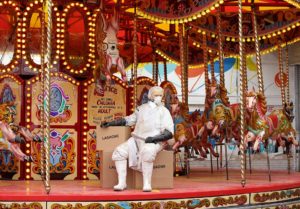Art & Science





I like Banksy; his art makes me think and sometimes it makes me laugh.I was reading about his latest art exhibition Dismaland which is currently set up as a ‘Bemusement ‘ park in Weston-super-Mare. Comedy gold on one hand, philosophical treatise on the other. It led me to consider why it is I think he is such a good artist while other ‘installation experts’ are such poor artists, if they can be dignified with the term. For starters, he can actually draw and paint, but that’s not it. There are whole genres of artwork where those skills are not required. I think what distinguishes his work is reference and thought. You may dislike it, it may seem nonsensical to you, but most people will be able to ‘get’ what he’s going on about unless they have no access to Western influences whatsoever. No matter how whimsical his work may seem, it always has an implicit ‘Why? ‘ embedded in there somewhere. Why are things this way, why is this acceptable, why are we not rioting in the streets about this? That’s what distinguishes it from say, Tracey Emin’s ‘Unmade bed’ which is utterly meaningless to anyone except Tracey Emin. Of course, the exhibition pleases me even more because the entry fee is only £3. Apart from the fact that 3 is one of my favoutite numbers (who doesn’t have favourite numbers? Have you considered the allure of the perfect number 9? Anyway as De La Soul sing ‘3, that’s the magic number’), it means just about everyone can afford to see it.
This artistry can be seen in artworks all down the ages. You do not need to know the subjects or characters in these paintings below for example, to be able to tap directly into what the artist is portraying — pain, sorrow, ease, rest, resignation, fear, loneliness, quietude — all are conveyed without the need for words.
That same ‘Why?’ lies behind most scientific endeavour. Artists and scientists are very similar in their outlooks. Apart from being at the back of the queue when the sanity gene was being handed out, they are alike in seeking to make sense of the world around them. This came to me when I was out walking this afternoon. It has been a boiling hot day and I noticed spongy bumps on the path through the Common. At first I thought I was imagining them, but No, there they were. It took some thought before I realised the path was a solid concrete floor overlaid with a gravel-asphalt mix. The binder in the mix had softened in the heat, and where it was improperly fixed to the concrete, it was buckling in the heat. Difference in coefficients of thermal expansion, seemples, as any fule kno. That’s what links art and science – why does water not flow uphill? why is the sky blue? why does the apple fall to the ground rather than float? why is the underside of the cloud darker than the top of the cloud? why is the colour of the sky different over water, over farming land, over deserts? if two different objects are dropped from the same height, do they reach the ground at the same time? if not, why not? From the discovery of how to make fire to the Nazca lines to anatomical physiology and pharmacognosy, the quest is the same.I’m going to make sure neither my inner scientist nor my inner artist withers away. I hope you’ll do the same.









Leave a Reply
Want to join the discussion?Feel free to contribute!